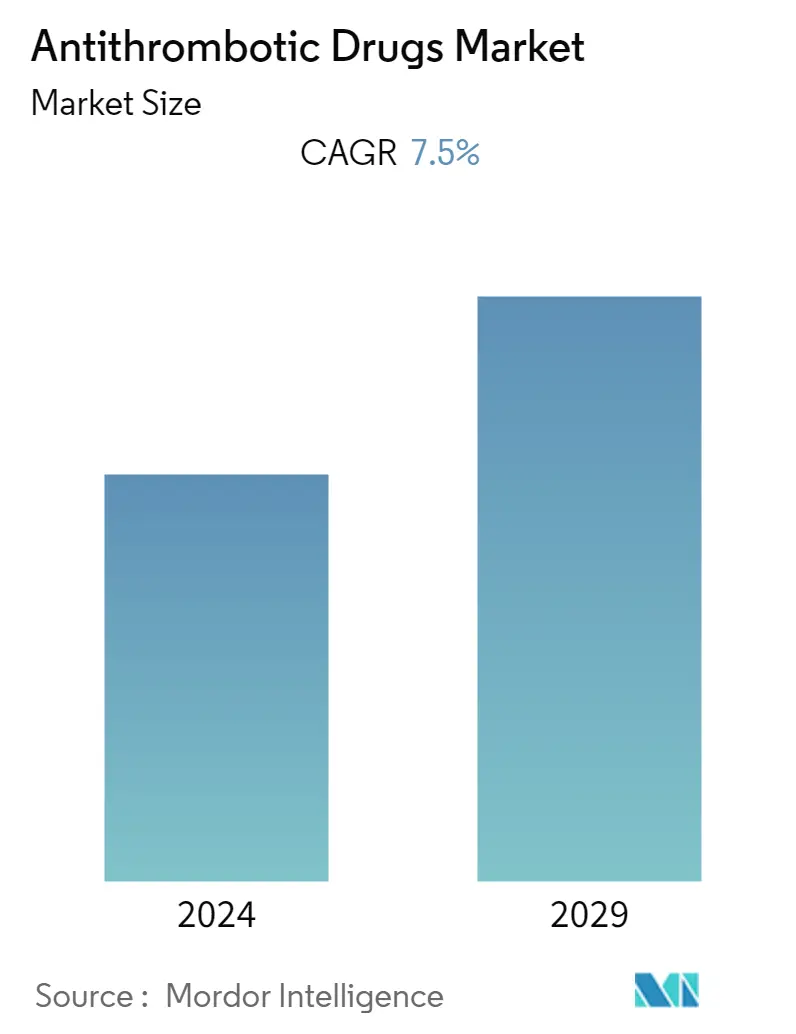Market Size of Antithrombotic Drugs Industry

| Study Period | 2020 - 2029 |
| Base Year For Estimation | 2023 |
| Forecast Data Period | 2024 - 2029 |
| CAGR | 7.50 % |
| Fastest Growing Market | Asia-Pacific |
| Largest Market | North America |
Major Players
*Disclaimer: Major Players sorted in no particular order |
Need a report that reflects how COVID-19 has impacted this market and its growth?
Antithrombotic Drugs Market Analysis
The antithrombotic drug market is projected to register a CAGR of 7.5% during the forecast period.
The COVID-19 pandemic imposed a high burden on the healthcare industry, increasing its focus on providing better healthcare facilities, monitoring devices, services, and teleconsultation. For instance, according to the NCBI article published in June 2021, more than half (53%) of the countries surveyed partially or completely disrupted services for hypertension treatment, and 31% for cardiovascular emergencies. Thus, the reduction in cardiovascular care services during the initial stages of the pandemic due to the strict lockdown procedures imposed by various governments had a significant impact on the market's growth during the pandemic period. However, the relaxation of stringent regulations during the post-pandemic period is expected to restore market growth over the next five years.
Certain factors that are propelling the growth of the market are the increase in the prevalence of cardiac and hereditary diseases and the growing demand for novel oral anticoagulants, coupled with the ageing population.
The rising burden of cardiac and hereditary diseases is the major factor driving demand for the antithrombotic drug market. For instance, the British Heart Foundation (BHF) data published in January 2022 reported that in 2021, the most common heart conditions affected globally were coronary (ischemic) heart disease (global prevalence estimated at 200 million), peripheral arterial (vascular) disease (110 million), stroke (100 million), and atrial fibrillation (60 million). The report also mentioned that the prevalence of heart and circulatory diseases in North America was 46 million, in Europe it was 99 million, in Africa it was 58 million, in South America it was 32 million, and in Asia and Australia it was 310 million. Such an increase in cardiovascular disease across the world is expected to increase the demand for antithrombotic drugs, thereby propelling market growth.
In addition, the increasing incidence and prevalence of diabetes mellitus and obesity among the population are also contributing to the demand for antithrombotic drugs as these patients are more susceptible to atherosclerotic cardiovascular events. In such cases, antiplatelet drugs are the secondary prevention method that reduces the risk of atherosclerotic cardiovascular events and their adverse prognostic consequences. For instance, according to the 2022 statistics published by the International Diabetes Federation in the 10th edition of 2021, in Germany, 6,199.9 thousand people lived with diabetes in 2021. Thus, an increasing number of people living with diabetes are at high risk of developing cardiovascular diseases, which is expected to increase the demand for antithrombotic drugs, thereby propelling market growth.
However, the stringent regulatory policies, high cost, and side effects of antithrombotic drugs are likely to restrain market growth over the forecast period.
